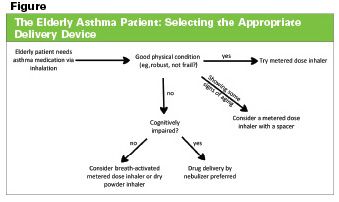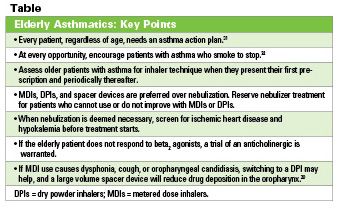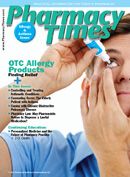Publication
Article
Pharmacy Times
The Elderly Patient with Asthma
Author(s):
In the United States, elderly patients with asthma are the most likely group to die of this breath-robbing disease. Advice is presented to help elderly asthma patients manage their disease and live longer lives.
In the United States, elderly patients with asthma are the most likely group to die of this breath-robbing disease. Advice is presented to help elderly asthma patients manage their disease and live longer lives.
Age and asthma can be and often are a lethal combination. Asthma’s symptoms—shortness of breath and wheezing—leave its victims gasping for air. Cough and tight chest—particularly at night and in the early morning—are intrusive. In the United States, elderly people with asthma are more likely to die of this breath-robbing disease than any other age group.1 Almost all of these deaths are preventable. How can we help our elders manage this disease better and live longer lives with less morbidity?
Elderly patients who have asthma can be classified in 2 groups: (1) those who were diagnosed as children and have carried the diagnosis for decades (long-standing asthma), and (2) those who are diagnosed late in life (late onset).
Traditionally, we believed that elders with long-standing asthma tend to have shorter symptom-free periods, more emergency needs, poorer lung function, and more hospitalizations than patients with late-onset asthma.2 Increasingly, the differences between long-standing and late-onset asthma seem less clear, with both leading to gradual but significant loss of ventilary capacity.2-4 This is particularly concerning in elders, because the aging lung is less pliant and flexible. The chest wall is more fixed due to age-related bone changes, and diaphragm flattening puts older lungs at a mechanical disadvantage. Parenchymal recoil is reduced.5-7 Compared with younger people, elders breathe at higher lung volumes, increasing the burden on chest walls and respiratory muscles and increasing metabolic demand.8 Of utmost concern is elders’ reduced ability to perceive bronchoconstriction.9
Atopic vs Nonatopic
Asthma diagnosed in childhood is usually atopic (or extrinsic) or classical allergic disease. These patients produce abnormal amounts of immunoglobulin E (IgE) when confronted with environmental allergens. They often present with the triad of asthma, eczema, and hay fever.10 This type of asthma develops most often in childhood, with risk becoming moderate in mid-life and low after age 65.11 Elevated IgE levels at any time in life increase the likelihood of an asthma diagnosis later, but sensitization to an allergen late in life is less likely. Elders with long-standing asthma often have fixed bronchial obstruction secondary to years of bronchial remodeling.12 This disease often looks like chronic obstructive pulmonary disease (COPD), and in patients who smoke, their diagnosis may move toward COPD.13
Nonatopic (intrinsic) asthma is more common in elders. In nonatopic asthma, airway activation occurs in response to viral or in vivo allergens; researchers have not identified these specifically.14,15 In elders, this type of asthma is usually diagnosed during or immediately after an upper respiratory infection.15
Diagnosis: Difficult
Among diagnostic tests used for asthma are the following:
• Spirometry to determine forced expiratory volume in 1 second (FEV1) and forced vital capacity (FVC);
• Change in FEV1/FVC ratio
• Beta agonist versus anticholinergic reversibility (symptom improvement of at least 12% after bronchodilator administration)
Pulmonologists consider elders’ expected lung changes, and the potential for fixed bronchial obstruction specifically, when interpreting these tests.8,16 Although symptom reversibility is generally considered the differentiating factor between asthma and COPD, lack of reversibility does not eliminate the possibility of asthma.17,18 In up to 10% of elderly patients, comorbidities, sensory deficits, dental or facial musculature problems, fatigue, or cognitive impairment can make these tests difficult to impossible to perform.19 When that is the case, pulmonologists resort to other measures that are acceptable but harder to perform.

Treatment
Before medications are considered, some lifestyle changes are key. Because many asthma patients smoke, smoking cessation is critical. Exercise and weight loss are helpful. Allergen avoidance makes sense, although no studies confirm its benefit.20
Basic asthma treatment is similar in all age groups: corticosteroids for maintenance and exacerbation (preventers), and inhaled beta agonists (relievers) for rescue when attacks break through. Although this paradigm is simple, application in elderly patients becomes complicated. Elders are more sensitive to the adverse effects of drugs and more likely to take concomitant medications, increasing the risk of drug interaction. They may have difficulties manipulating inhalers and coordinating their breathing with the device. Cognitive impairment can be a serious impediment. 8 Medication generally comes in pressurized metered dose inhalers (MDIs), dry powder inhalers (DPIs), or nebulizers. Selecting the method of administering asthma medication to an elder is described in the Figure.
Beta2 Agonists and Anticholinergics
Beta2 agonists relax airway smooth muscle and may have an anti-inflammatory effect. They represent a first step when medication is needed intermittently, but only if the patient can recognize bronchoconstriction.20 Older patients generally respond well to beta2 agonists, but may be more likely to develop dose-dependent tachycardia, tremulousness, or palpitations. Hypokalemia—a known side effect—is increased in elders who take diuretics or insulin. Concurrent theophylline increases risk of myocardial complications in older patients.21,22 If elders use short-acting beta2 agonists (salbutamol/ levosalbutamol, terbutaline, metaproterenol, albuterol) more than twice a week for rescue, pharmacists should encourage them to see their physician, as this indicates suboptimal control. Long-acting beta2 agonists include salmeterol, formoterol, and bambuterol. Anticholinergics (ipratropium, tiotropium) work via vagal inhibition and are an alternative for elders who cannot use beta2 agonists or do not respond to beta2 agonists because of age-related receptor changes.8 Patients do not usually experience typical anticholinergic effects when these drugs are inhaled.
Corticosteroids
Steroids are indicated in all age groups, as they have decreased overall morbidity and mortality from asthma.23 Osteoporosis is a serious and common problem in the elderly, and oral corticosteroids increase its incidence and severity,24 so inhaled agents are preferred. Although inhaled agents decrease bone mineral density,25,26 studies have not yet documented increased fracture rates. The benefits of inhaled corticosteroids (ICSs) in older patients with asthma far outweigh the risks,27 but only about one third of patients with asthma use ICSs.28 Early initiation of the lowest effective dose with close monitoring is reasonable and life-saving. Although these are usually given by MDI or DPI, nebulization is possible, but only if absolutely necessary; the large doses needed in nebulization can cause or exacerbate osteoporosis.29 When inhaled by MDI, these drugs may cause dysphonia, cough, or oropharyngeal candidiasis.20
Anti-IgE Therapy
In allergy-related asthma, the monoclonal antibody omalizumab can be helpful. Administered as a subcutaneous injection every 2 to 4 weeks, omalizumab has been shown to reduce asthma symptoms in older individuals. Potential side effects include increased risk of parasitic infection and adrenal insufficiency.30
Other Drugs
Most asthma can be controlled using the agents described above. When it is not, methylxanthines, leukotrienemodifying agents, and cromones may help.
End Note
The Table describes key points for pharmacists with regard to asthma in the elderly. In addition to educating older patients with asthma about their disease, pharmacists should encourage annual vaccination against influenza and pneumococcal polysaccharide vaccine every 5 years. Very basic patient education about “preventers” and “relievers” should occur at each visit. â–

Ms. Wick is a senior clinical research pharmacist at the National Cancer Institute, National Institutes of Health, Bethesda, Maryland. The views expressed are those of the author and not those of any government agency.
References
1. Moorman JE, Rudd RA, Johnson CA, et al; Centers for Disease Control and Prevention (CDC). National surveillance for asthma--United States, 1980-2004. MMWR Surveill Summ. 2007;19;56:1-54.
2. Braman SS, Kaemmerlen JT, Davis SM. Asthma in the elderly: A comparison between patients with recently acquired and long standing disease. Am Rev Respir Dis 1991;143:336—340.
3. Burrows B, Barbee RA, Cline MG et al. Characteristics of asthma among elderly adults in a sample of the general population. Chest 1991;100:935—942.
4. Miranda C, Busacker A, Balzar S et al. Distinguishing severe asthma phenotypes: Role of age at onset and eosinophilic inflammation. J Allergy Clin Immunol 2004;113:101—108.
5. Crapo RO. The ageing lung. In: Mahler DA, ed. Pulmonary Disease in the Elderly Patient, Vol. 63. New York: Marcel Dekker, 1993, pp 1—21.
6. Edge J, Millard F, Reid L. The radiograph appearance of the chest in persons of advanced age. Br J Radiol 1984;37:769—774.
7. Polkey MI, Harris ML, Hughes PD et al. The contractile properties of the elderly human diaphragm. Am J Respir Crit Care Med 1997;155:1560—1564.
8. Chotirmall SH, Watts M, Branagan P, Donegan CF, Moore A, McElvaney NG. Diagnosis and management of asthma in older adults. J Am Geriatr Soc. 2009;57:901-9.
9. Connolly MJ, Crowley JJ, Charan NB, Nielson CP, Vestal RE. Reduced subjective awareness of bronchoconstriction provoked by methacholine in elderly asthmatic and normal subjects as measured on a simple awareness scale. Thorax. 1992;47:410-3.
10. Dow L, Coggon D, Campbell MJ et al. The interaction between immunoglobulin E and smoking in airflow obstruction in the elderly. Am Rev Respir Dis 1992;146:402—407.
11. Barbee RA, Lebowitz MD, Thompson HC et al. Immediate skin-test reactivity in a general population sample. Ann Intern Med 1976;84:129—133.
12. Laitinen LA, Laitinen A, Altraja A et al. Inflammatory determinants of asthma severity- bronchial biopsy findings in intermittent or early asthma. J Allergy Clin Immunol 1996;98(Suppl):S3—S6.
13. Cassino C, Berger KI, Goldring RM et al. Duration of asthma and physiologic outcomes in elderly nonsmokers. Am J Respir Crit Care Med 2000;162:1423—1428.
14. Kay AB. Pathology of mild, severe and fatal asthma. Am J Respir Crit Care Med 1996;154:S66—S69.
15. Bauer BA, Reed CE, Yunginger JW et al. Incidence and outcomes of asthma in the elderly: A population-based study in Rochester, Minnesota. Chest 1997;111:303—310.
16. American Thoracic Society. Lung function testing: Selection of reference values and interpretative strategies. Am Rev Respir Dis 1991;144:1202—1218.
17. Brand PLP, Quanjer PH, Postma DS et al. Interpretation of bronchodilator response in patients with obstructive airways disease. Thorax 1992;47:429—436.
18. Dompeling E, van Schayck CP, Molema J et al. A comparison of six different ways of expressing the bronchodilating response in asthma and COPD: Reproducibility and dependence of prebronchodilator FEV1. Eur Respir J 1992;5:975—981.
19. Dow L, Coggon D, Osmond C et al. A population survey of respiratory symptoms in the elderly. Eur Respir J 1991;4:267—272.
20. Barua P, O'Mahony MS. Overcoming gaps in the management of asthma in older patients: new insights. Drugs Aging. 2005;22:1029-59.
21. Joseph X, Whitehurst VE, Bloom S et al. Enhancement of cardiac effects of beta-adrenergic bronchodilators by aminophylline in experimental animals. Fundam Appl Toxicol 1981;1:443—447.
22. Lai CKW, Legge JS, Friend JAR. Air-driven nebulised high-dose salbutamol in severe chronic obstructive airways disease: Is it safe? Respiration 1991;18:641—644.
23. Goldstein MF, Fallon JJ, Harning R. Chronic glucocorticoid therapy induced osteoporosis on patients with obstructive lung disease. Chest 1999;116:1733—1749.
24. Smith BJ, Phillips PJ, Heller RF. Asthma and chronic obstructive airway disease are associated with osteoporosis and fractures. Respirology 1999;4:101—109.
25. Ip M, Lam K, Yam L et al. Decreased bone mineral density in premenopausal asthma patients receiving long-term inhaled steroids. Chest 1994;105:1722—1727.
26. Israel E, Banerjee TR, Fitzmaurice GM et al. Effects of inhaled glucocorticoids on bone density in premenopausal women. N Engl J Med 2001;345:941—947.
27. Slavin RG, Haselkorn T, Lee JH et al. Asthma in older adults: Observations from the epidemiology and natural history of asthma: outcomes and treatment regimens (TENOR) study. Ann Allergy Asthma Immunol 2006;96:406—414.
28. Enright PL, Mc Clelland RL, Newman AB et al. Underdiagnosis and under treatment of asthma in the elderly. Chest 1999;116:603—613.
29. Saag KG, Shane E, Boonen S et al. Teriparatide or alendronate in glucocorticoid-induced osteoporosis. N Engl J Med 2007;357:2028—2039.
30. Maykut RJ, Kianifard F, Geba GP. Response of older patients with IgE-mediated asthma to omalizumab: A pooled analysis. J Asthma 2008;45:173—181.
31. Goeman DP, Sanci LA, Scharf SL, et al. Improving general practice consultations for older people with asthma: a cluster randomised control trial. Med J Aust. 2009;191:113-7.
32. Bellia V, Pedone C, Catalano F, et al. Asthma in the elderly: mortality rate and associated risk factors for mortality. Chest. 2007;132:1175-82.







